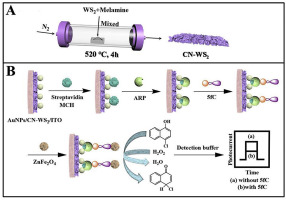当前位置:
X-MOL 学术
›
Biosens. Bioelectron.
›
论文详情
Our official English website, www.x-mol.net, welcomes your
feedback! (Note: you will need to create a separate account there.)
One step preparation of CN-WS2 nanocomposite with enhanced photoactivity and its application for photoelectrochemical detection of 5-formylcytosine in the genomic DNA of maize seedling.
Biosensors and Bioelectronics ( IF 10.7 ) Pub Date : 2019-12-19 , DOI: 10.1016/j.bios.2019.111973 Fei Li 1 , Yunlei Zhou 1 , Siyu Wang 1 , Huanshun Yin 1 , Yan Chen 1 , Huiyun Luo 1 , Shiyun Ai 1
Biosensors and Bioelectronics ( IF 10.7 ) Pub Date : 2019-12-19 , DOI: 10.1016/j.bios.2019.111973 Fei Li 1 , Yunlei Zhou 1 , Siyu Wang 1 , Huanshun Yin 1 , Yan Chen 1 , Huiyun Luo 1 , Shiyun Ai 1
Affiliation

|
Carbon nitride and WS2 nanocomposite (CN-WS2) with excellent photoelectric activity was prepared by one-step thermal polymerization. By the new strategy of simultaneously loading C and N elements on pure WS2, the formation of CN-WS2 brings high mobility, ultra-fast charge carrier separation and transport, and slows down the recombination rate of electrons and holes. Then, a novel photoelectrochemical biosensor was constructed for 5-formylcytosine detection based on CN-WS2 composite, aldehyde reaction probe (ARP) and ZnFe2O4, where CN-WS2 composite was employed as photoactive material, ARP was used as 5-formylcytosine capture reagent, and ZnFe2O4 was adopted as artificial mimic enzyme. Under the catalysis effect of ZnFe2O4, 4-chloro-1-naphthol was quickly oxidized by H2O2 to produce the insoluble substance of benzo-4-chlorohexadienone, which would be deposited on the electrode surface and caused a decreased PEC response. Under optimal experimental conditions, the biosensor showed low detection limit of 3 pM. This method can also discriminate 5-formylcytosine with other cytosine derivatives. More importantly, the applicability of this method was demonstrated by assessing the effect of antibiotics on the content of 5-formylcytosine in the root, stem and leave of maize seedlings.
中文翻译:

具有增强光活性的CN-WS2纳米复合材料的一步制备及其在玉米幼苗基因组DNA中光化学检测5-甲酰基胞嘧啶中的应用。
通过一步热聚合制备了具有优异光电活性的氮化碳和WS2纳米复合材料(CN-WS2)。通过在纯WS2上同时加载C和N元素的新策略,CN-WS2的形成带来了高迁移率,超快速的载流子分离和传输,并减慢了电子和空穴的复合速率。然后,基于CN-WS2复合物,醛反应探针(ARP)和ZnFe2O4,构建了一种新型的用于5-甲酰基胞嘧啶检测的光电化学生物传感器,其中CN-WS2复合物为光敏材料,ARP为5-甲酰基胞嘧啶捕获剂,采用ZnFe2O4作为人工模拟酶。在ZnFe2O4的催化作用下,4-氯-1-萘酚迅速被H2O2氧化,生成不溶性的苯并4-氯己二酮,会沉积在电极表面上,并导致PEC响应降低。在最佳实验条件下,该生物传感器显示出3 pM的低检测限。该方法还可以将5-甲酰基胞嘧啶与其他胞嘧啶衍生物区分开。更重要的是,通过评估抗生素对玉米幼苗根,茎和叶中5-甲酰基胞嘧啶含量的影响,证明了该方法的适用性。
更新日期:2019-12-19
中文翻译:

具有增强光活性的CN-WS2纳米复合材料的一步制备及其在玉米幼苗基因组DNA中光化学检测5-甲酰基胞嘧啶中的应用。
通过一步热聚合制备了具有优异光电活性的氮化碳和WS2纳米复合材料(CN-WS2)。通过在纯WS2上同时加载C和N元素的新策略,CN-WS2的形成带来了高迁移率,超快速的载流子分离和传输,并减慢了电子和空穴的复合速率。然后,基于CN-WS2复合物,醛反应探针(ARP)和ZnFe2O4,构建了一种新型的用于5-甲酰基胞嘧啶检测的光电化学生物传感器,其中CN-WS2复合物为光敏材料,ARP为5-甲酰基胞嘧啶捕获剂,采用ZnFe2O4作为人工模拟酶。在ZnFe2O4的催化作用下,4-氯-1-萘酚迅速被H2O2氧化,生成不溶性的苯并4-氯己二酮,会沉积在电极表面上,并导致PEC响应降低。在最佳实验条件下,该生物传感器显示出3 pM的低检测限。该方法还可以将5-甲酰基胞嘧啶与其他胞嘧啶衍生物区分开。更重要的是,通过评估抗生素对玉米幼苗根,茎和叶中5-甲酰基胞嘧啶含量的影响,证明了该方法的适用性。









































 京公网安备 11010802027423号
京公网安备 11010802027423号